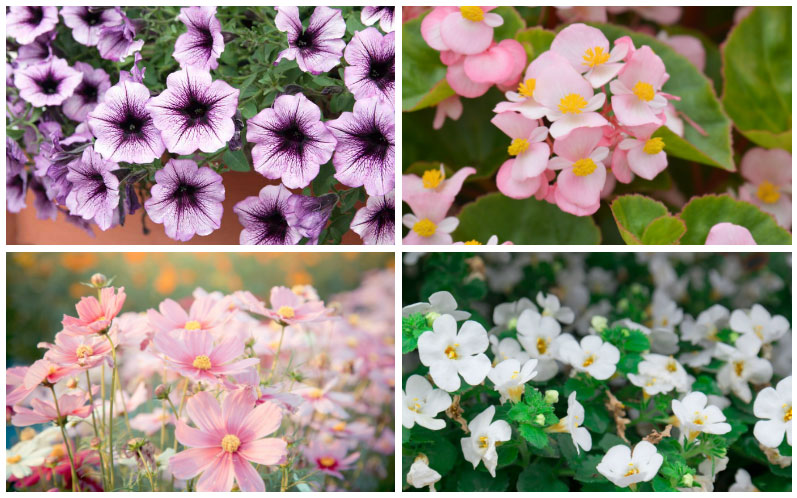
Annuals can be a beautiful addition to any garden. Their vibrant flowers and patterns fill out any gaps in design beautifully, especially if you’re choosing a trailing plant. These plants grow long and elegant, often draping over the edges of beds or along trellises.
Unsure of what to plant in your garden this year? Consider planting one of these trailing annuals.
Blue Star Creepers
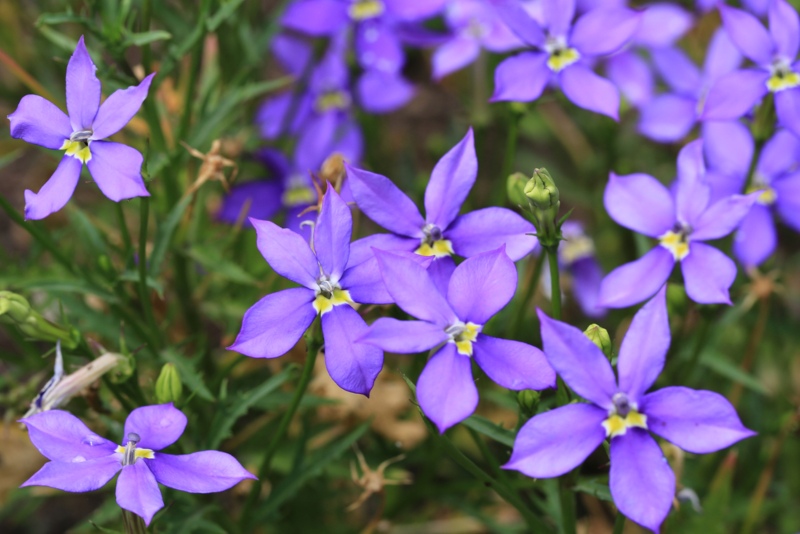
Known botanically as Isotoma fluviatilis, the blue star creeper is an excellent ground cover plant. Its long, trailing leaves and flowers make great filler between shrubs and in containers meant to hang and spillover. Blue star creepers are, as the name implies, available in soft shades of blue.
These plants grow best in beds and planters that get either full or partial sun for at least six hours a day and grow well in the spring and summer. They should be kept in moist, well-drained soil that is loose or gravel-like.
Cup and Saucer Vine

Cup and saucer vines, botanically Cobaea scandens, can be grown as either perennial (with proper care) or, more commonly, as annuals. They’re long, trailing vines that grow clusters of gorgeous flowers that resemble a small teacup with a saucer. These flowers are usually purple with white edges and proliferate alongside their lightweight light-green leaves.
Typically grown in Mexico, cup and saucer vines thrive in heat, sun, and neutral or slightly acidic, well-drained soil. They can grow up to 20 feet long and 6 feet wide, so they require a lot of room. The soil should be kept moist with regular watering during the growing season, with water reduced dramatically in the winter months.
Creeping Zinnia
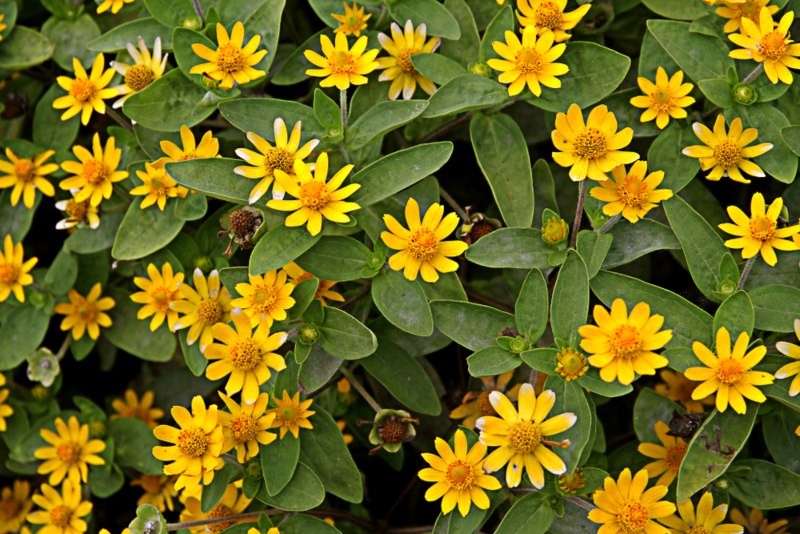
Creeping Zinnias, botanically Sanvitalia procumbens, are small, bright, golden yellow flowers that grow alongside small, waxy leaves. Another Mexican native, these flowers can grow up to 18 inches in length and bloom well in late summer through the early part of fall. The lovely thing about these plants is that they are low on natural pests, making them fairly low maintenance.
Planting these flowers in the early spring gives them the best chance of blooming well and early. They like loamy, well-drained soil in containers (which is how they best thrive) and appreciate monthly fertilizing and moist, but not wet, soil.
Nasturtium

Tropaeolum majus, or Nasturtiums, are large, summer, and fall-blooming flowers that can come in orange, red, white, or yellow, and grow on vines alongside circular deep green leaves. They’re a pollinator-attracting flower, meaning they smell amazing and will attract bees, butterflies, and hummingbirds. The flowers are also edible!
Nasturtiums like sandy, moist soil and gentle sunlight. They need to be trimmed occasionally for dead flowers and dying leaves, as trimming will encourage new growth. To collect the flowers for eating, simply snip them off with scissors and clean them gently before adding them as a garnish.
Wave Petunias

Wave petunias, or Petunia atkinsiana, are gorgeous, small flowers that come in shades of purple. They’re simple to care for and spread across flowerbeds up to four feet long. They can also cover fences if planted densely along the base and well supported.
Wave petunias do well with biweekly fertilizing and gentle watering in either regular or potting soil. They don’t need to be deadheaded, like their cousins, and don’t even need trimming, making them an excellent plant for first-time gardeners.
Million Bells
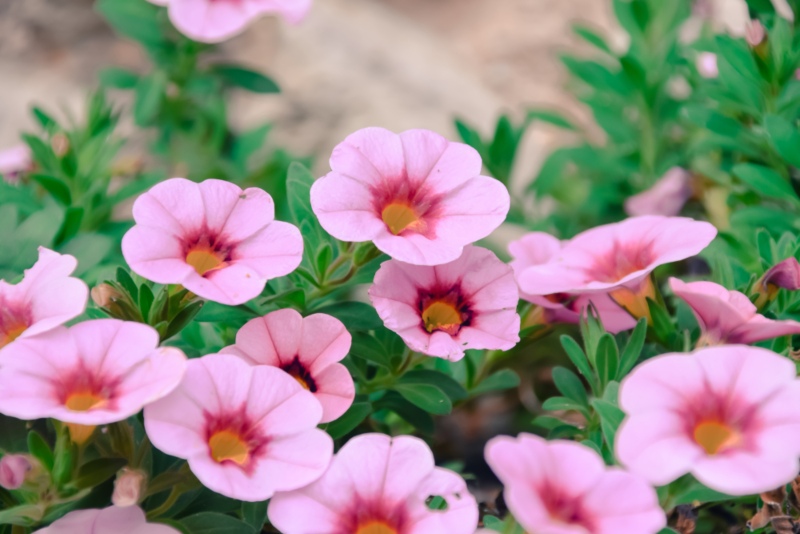
Million bells are a kind of trailing petunia called Calibrachoa. The flowers of this hybrid plant come in a wide variety of colors, from pinks, whites, and reds to violets, blues, and even bronze. They make excellent container plants and can be grown as either perennials or annuals.
Blooming in the spring and continuing to do so until the first frost of the year, million bells thrive in full sun, and rich, well-draining soil kept moist. They should be fertilized every two weeks or so with liquid fertilizer and enjoy humid environments, meaning if you live in a dry area, you’ll need to mist them daily.
Trailing Lobelia

Trailing Lobelia, botanically Lobelia erinus, are lovely, bright flowers that can be blue, violet, pink, purple, or white and grow in clusters along their vines. They make excellent hanging plants, spilling elegantly over the sides or as filler in containers and beds where they are allowed to spread out. They attract butterflies but are often ignored by deer, reducing a common pest problem.
These flowers like full or partial sun and rich, moist, well-drained soil out of intense heat. They’re hearty plants not known for many diseases or pest issues and should be deadheaded to encourage growth.
Sweet Alyssum

Sweet Alyssum, or Alyssum maritimum, is heat-resistant, drought-resistant, and smells, as the name suggests, sweet and light. They’re a variant of the mustard family and bloom in small clusters of dainty flowers. Their blooms can be pink, purple, white, yellow, or a few other variants, and they do well in planters and baskets.
These flowers need well-drained soil, though the type of soil is flexible – they adapt quickly. They need moderate amounts of moisture and good amounts of sunlight to prevent stem rot. They can be trimmed and deadheaded to encourage blooming, even late in the season.
Begonia
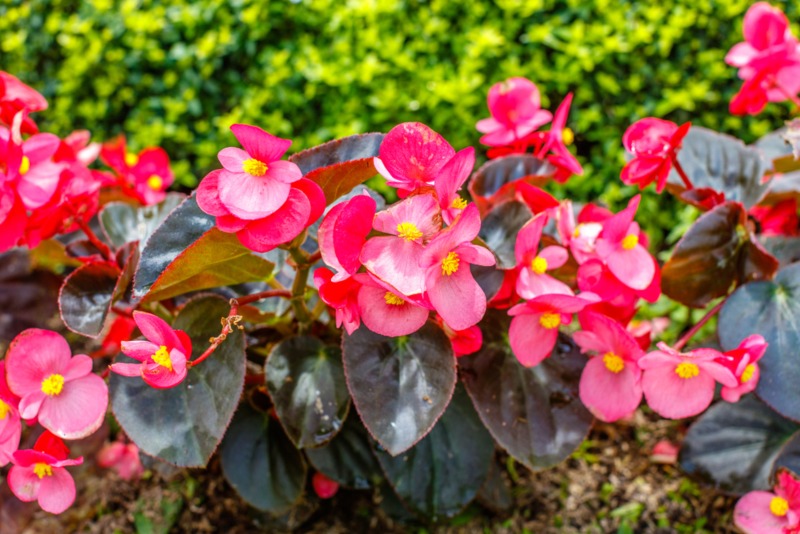
There are multiple kinds of begonia that suit trailing in baskets, hanging planters, and edging for larger beds. “Illumination” begonias come in a wide variety of colors that double bloom and look great in hanging baskets. In contrast, begonia boliviensis, or “hanging begonias,” look like stars stretched in arches that dangle from baskets or boxes and are known for a brilliant scarlet-orange bloom.
Begonias like moist, organically rich soil that drains well and partially shaded areas. They don’t attract deer or rabbits and do well on light, slow-release fertilization. It’s best to water them via methods that don’t directly hit the leaves, to prevent fungal issues, and to use a very gentle and begonia-tested insecticide to prevent bug problems.
Impatiens

Impatiens are flowers that go almost solely by their botanical name, though they are sometimes called “Busy Lizzies.” Their five-petal flowers can be orange, pink, purple, red, white, or yellow, with differently colored centers. These gorgeous flowers attract birds and other pollinators.
Impatiens should be planted in moist, loamy soil, somewhere that isn’t too windy (the flowers are delicate). They like partial sun and gentle, consistent watering. Well cared for, these flowers will grow up to 30 inches tall and stay relatively low to the ground.













